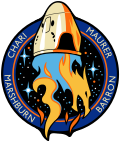- Crew-3 astronauts during dress rehearsals
- Launch of Crew-3
- Crew Dragon Endurance approaches the ISS
- Crew-3 reenters the atmosphere
- Crew Dragon Endurance on MV Shannon after splashdown
- Crew-3 astronauts after splashdown
 Endurance docked at the ISS | |
| Names | USCV-3 |
|---|---|
| Mission type | ISS crew transport |
| Operator | SpaceX |
| COSPAR ID | 2021-103A |
| SATCAT no. | 49407 |
| Mission duration | 176 days, 2 hours, 39 minutes, 52 seconds |
| Spacecraft properties | |
| Spacecraft | Crew Dragon Endurance |
| Spacecraft type | Crew Dragon |
| Manufacturer | SpaceX |
| Launch mass | 12,055 kg (26,577 lb) [1] |
| Crew | |
| Crew size | 4 |
| Members | |
| Expedition | Expedition 66/67 |
| Start of mission | |
| Launch date | November 11, 2021, 02:03:31 UTC (November 10, 9:03:31 pm EDT) |
| Rocket | Falcon 9 Block 5 B1067-2 |
| Launch site | Kennedy, LC‑39A |
| End of mission | |
| Recovered by | MV Shannon |
| Landing date | May 6, 2022, 04:43:23 UTC (12:43:23 am EDT) [2] |
| Landing site | Gulf of Mexico, near Clearwater, Florida |
| Orbital parameters | |
| Reference system | Geocentric orbit |
| Regime | Low Earth orbit |
| Inclination | 51.66° |
| Docking with ISS | |
| Docking port | Harmony forward |
| Docking date | November 11, 2021, 23:32 UTC |
| Undocking date | May 5, 2022, 05:20 UTC [2] [3] |
| Time docked | 174 days, 5 hours, 48 minutes |
   NASA (left), [4] SpaceX (middle), and ESA (right) mission patches  From left: Chari, Marshburn, Maurer and Barron | |
SpaceX Crew-3 was the Crew Dragon's third NASA Commercial Crew operational flight, and its fifth overall crewed orbital flight. The mission successfully launched on November 11, 2021, at 02:03:31 UTC to the International Space Station. [5] It was the maiden flight of Crew Dragon Endurance. [6]
Contents
This launch brought the total number of humans who have been to space to more than 600 with Maurer (600) and Barron (601). [7]








